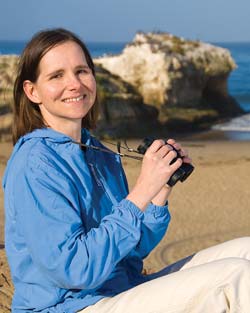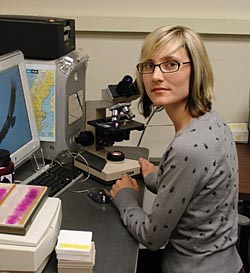At UC Santa Cruz, graduate student research is not just about earning a degree. In every field of advanced study, UCSC attracts graduate students who are eager to acquire the knowledge and skills they need to find solutions to global challenges.
The disciplines of biological and environmental sciences illustrate perfectly the opportunities UCSC grad students have to do meaningful work that has real-world applications. In fact, in several recent high-profile cases, thesis research by UCSC graduate students in those fields has been the decisive factor in changing government policies and corporate actions.
"Most of the students I work with don't have a vision of themselves as academics--they want to save the world," says Donald Croll, associate professor of ecology and evolutionary biology. "So we try to give students direct, hands-on opportunities in conservation biology."
One of Croll's students helped mount a successful legal challenge that blocked the construction of a liquefied natural gas terminal near a major seabird nesting colony. Two students in environmental toxicology, meanwhile, documented the sources of lead poisoning in albatrosses and California condors, prompting government actions to protect the birds. Here are their stories:
Threatened Islands
The Coronado Islands are located off the coast of Baja California, just south of the Mexican border. As part of her research for a master's degree in ocean sciences, graduate student Shaye Wolf documented the large and diverse populations of seabirds that nest on the Coronado Islands. These include the largest known colony of the rare Xantus's murrelet, a small seabird listed as endangered under Mexican law and threatened in California.
While she was doing her research, Wolf learned that Chevron was planning to build a liquefied natural gas (LNG) terminal less than 700 yards from the south island, which hosts the Xantus's murrelet colony. The murrelets and four other species that nest on the island are nocturnal, and Wolf was especially concerned about the effects of the terminal's lights.
"These nocturnal seabirds are very sensitive to artificial light, and the tremendous amount of lighting from the terminals and tankers would have been devastating," Wolf says. "It doesn't make sense to put a big industrial facility the size of a football field right next to a biodiversity hot spot."
Through her husband Doug Bevington, a UCSC graduate student in sociology studying environmental advocacy groups, Wolf learned that a cross-border legal challenge could be filed through the Commission for Environmental Cooperation of the North American Free Trade Agreement (NAFTA). Bevington, who earned his Ph.D. in June, contacted Jay Tutchton, director of the Environmental Law Clinical Partnership at the University of Denver, who agreed to help them file a petition with the NAFTA Commission.
Wolf wrote the science portion of the petition, Tutchton wrote the legal portion, and Bevington assembled a coalition of environmental groups to join them. Filed in 2005, the petition ultimately led to Chevron's announcement in March 2007 that it was abandoning its plans to build the LNG facility at the Coronado Islands site. Wolf earned a Ph.D. in ecology and evolutionary biology this year and now works for the nonprofit Center for Biological Diversity.
Condor Crisis
In 1982, the total population of California condors was just 22 birds. Four years later, as the wild population continued to plummet, biologists decided to capture the remaining wild condors and breed them in captivity. Now, 140 captive-bred California condors are flying free in California, Arizona, and Baja California.
But life in the wild is still full of hazards for this critically endangered species. Lead poisoning is one of the most serious and persistent threats to wild condors. At least 13 have died from lead poisoning, and dozens more have had to be captured and treated for it.
Conservationists have long believed that the problem results from the use of lead ammunition by hunters. Condors feed on carrion and can ingest fragments of lead bullets from animal carcasses and gut piles left behind by hunters.
Past efforts to ban lead ammunition in California have been stymied by opposition from hunting groups. But this year the situation is very different. As a direct result of a scientific study led by UCSC graduate student Molly Church, the California Department of Fish and Game recommended a ban on the use of lead bullets throughout the range of the California condor. Legislation to enact such a ban is now moving through the state legislature.
Church, who earned a master's degree in environmental toxicology in 2004 and is now at the University of Pennsylvania's School of Veterinary Medicine, was able to match the lead in blood samples from condors to the lead in ammunition obtained from a variety of sources throughout central California. She used a proven "fingerprinting" technique based on the unique isotope ratios found in different sources of lead.
Donald Smith, professor and chair of environmental toxicology, was Church's adviser and a coauthor of the scientific paper reporting her findings. He has testified at several hearings in Sacramento before State Senate and Assembly committees considering the bill to ban lead ammunition.
"Had it not been for the outstanding science in Molly's paper, the professional lobbyists for hunter-advocacy groups testifying in opposition to the bill would have gone unchallenged," Smith says.
Cleaning up Midway
Lead poisoning also affects albatrosses that nest on Midway Atoll, a former military base where lead-based paint from deteriorating buildings is an ongoing problem. Myra Finkelstein documented the problem as a UCSC graduate student in environmental toxicology and ocean sciences.
More than 400,000 nesting pairs of Laysan and black-footed albatrosses breed on Midway every year. Lead poisoning mainly affects Laysan albatross chicks in nests near the contaminated buildings. Finkelstein showed that the problem is a direct result of chicks eating paint chips in and around their nests. She estimates that as many as 10,000 chicks, or five percent of those hatched at Midway, die each year from lead poisoning.
Finkelstein's findings helped the U.S. Fish and Wildlife Service, which manages the Midway Atoll National Wildlife Refuge, to target its clean-up efforts. But a lack of adequate funding has meant that albatross chicks continue to suffer and die from lead poisoning.
"The U.S. Fish and Wildlife Service has been trying to clean it up, but their budget is limited," Finkelstein says. "The estimate for getting rid of all the lead-based paint was $5.6 million."
Finkelstein earned her Ph.D. in 2003 and is currently a David H. Smith Conservation Research Fellow in the Department of Ecology and Evolutionary Biology. As part of her fellowship, she has been working with the American Bird Conservancy, a nonprofit conservation group, to publicize the plight of the albatrosses on Midway.
In 2006, the group saw an opportunity to draw attention to the situation when Midway Atoll became part of the newly created Northwestern Hawaiian Islands Marine National Monument. As a result of their efforts, First Lady Laura Bush visited Midway in March 2007 to highlight the creation of the monument and the conservation issues it faces, and she expressed her support for efforts to fund the clean-up of lead paint.
"We're very hopeful that the money will be made available," Finkelstein says. "It's a beautiful island, and there does seem to be a growing recognition that this problem needs to be dealt with in a timely manner."





